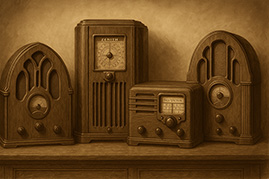Notable Antique Radio Brands
Old-time radios, popular from the 1920s through the 1950s, not only served as essential household entertainment devices but also showcased the design aesthetics of their eras. These radios came in various styles and were produced by numerous manufacturers. Here's a detailed overview of some notable brands and styles:
📻 Notable Antique Radio Brands
- Philco was a leading radio manufacturer in the 1930s and 1940s. Their "cathedral" style radios, like the Philco Model 90, featured arched wooden cabinets and intricate designs. These radios were known for their reliability and became iconic in American homes.
- Zenith produced high-quality radios with innovative features. The Zenith Trans-Oceanic series, introduced in the 1940s, was notable for its portability and ability to receive shortwave broadcasts, making it popular among travelers and military personnel.
- RCA Victor was a major player in the radio industry. Their Model 66X1, a tabletop radio from the 1940s, combined functionality with sleek design. RCA radios were known for their technological advancements and sound quality.
- Atwater Kent was renowned for producing radios with superior craftsmanship in the 1920s and early 1930s. Models like the Atwater Kent Model 55C featured ornate wooden cabinets and were prized for their durability.
🏛️ Distinctive Radio Styles
📐 Cathedral Radios Popular in the early 1930s, cathedral radios had arched tops resembling church windows. Their wooden cabinets often featured intricate carvings and were designed to be both functional and decorative.🧱 Tombstone Radios These radios, prevalent in the mid-1930s, had a rectangular, upright design. They were more compact than cathedral radios but still featured elaborate woodwork and detailing.
🧳 Console Radios Standing floor models, console radios were large and often integrated into furniture pieces. They became central fixtures in living rooms, offering powerful speakers and multiple tuning options.
🧼 Bakelite Radios With the advent of new materials in the late 1930s and 1940s, radios began to feature Bakelite plastic cases. These radios came in various colors and streamlined designs, reflecting the Art Deco movement.

Old-time radios